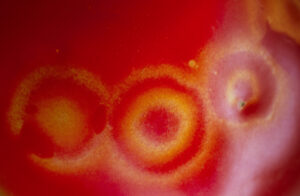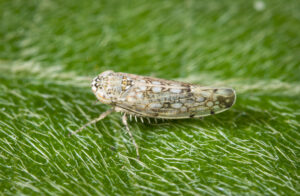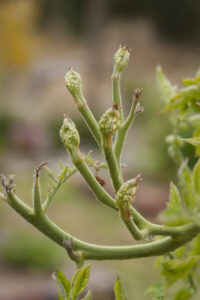
Insects that transmit plant diseases
By Denis Crawford
Insects that spread plant diseases are known as vectors of that disease. It’s important to know that some insects are more efficient vectors than other others.
Insects which transmit plant diseases are mostly sap-sucking insects of the insect order Hemiptera. Common hemipteran insects that may transmit plant diseases include aphids, leafhoppers, and whiteflies. What these insects have in common are piercing, sucking mouthparts. Some species of thrips (order Thysanoptera) also transmit plant viruses. Thrips have piercing, sucking mouthparts that are not as tube-like as those of hemipteran insects.
Common plant diseases spread by the insects mentioned above include cucumber mosaic virus, iris mosaic virus, tomato big bud, and tomato spotted wilt virus. The insects feed on fluids within plant cells and acquire plant diseases from infected plants and may transmit them to uninfected plants. Most plant diseases have a particular type of insect vector. For example, cucumber mosaic virus is spread by aphids, tomato big bud is transmitted by a species of leafhopper, while tomato spotted wilt virus is spread by thrips.
February 2024 Nursery Papers detailed how one plant pathogen, the bacterial disease Xylella fastidiosa, is a significant threat to Australia’s horticultural industries. The disease has not been detected in Australia yet, but it is a potential risk to fruit trees such as stone fruit, grapes and olives, as well as ornamental trees such as oak, elm, and maple.

Xylella fastidiosa is spread by xylem feeding sap-sucking insects, especially the insects known as spittlebugs and sharpshooters. The fact that Xylella is only spread by xylem feeding insects rules out insects such as aphids, psyllids and whiteflies which are phloem feeding insects. Phloem sap has a high sugar content and most of the insects that feed on phloem sap are notorious for excreting vast amounts of honeydew – i.e. excess plants sugars.
No vectors of Xylellahave been identified in Australia yet, but there are a number of potential vectors. Xylem feeding insects include froghoppers and spittlebugs of the superfamily Cercopoidea, cicadas of the superfamily Cicadoidea, and leafhoppers of the subfamily Cicadellinae. Research has shown that there are over 200 native xylem sap-feeding insects in Australia, predominantly in Queensland and New South Wales, that are potential vectors of Xylella.
In the northern hemisphere, the meadow spittlebug (Philaenus spumarius) and the glassy-winged sharpshooter (Homalodisca vitripennis) are the most efficient vectors of Xylella fastidiosa. Neither of these insects occur in Australia. The most likely way that Xylella could make it into Australia is in infected plant material, or in infected insects. So far, our biosecurity agencies have managed to keep them out.

Xylem feeding sap-suckers, like the glassy-winged sharpshooter, can acquire the Xylella bacterium while feeding on an infected plant. Research shows the bacterium can survive and colonize the inner linings of the mouthparts. If an adult insect acquires Xylella, they can transmit it for the rest of their lives. Importantly, they can transmit the bacterium to an uninfected plant immediately.
Let’s compare that to the common brown leafhopper (Orosius orientalis), the vector of tomato big bud disease – a phytoplasma pathogen. Firstly, the common brown leafhopper is not a member of the leafhopper subfamily Cicadellinae and is not viewed as a potential vector of Xylella. Secondly, the leafhopper can’t transmit the tomato big bud pathogen immediately after feeding on an infected plant. It can only transmit it after an incubation period of 10 to 45 days, depending on the temperature.
The reason for the incubation period is that the acquired phytoplasma must multiply in the

intestinal cells of the insect, then pass into the haemolymph (insect blood), and finally reach and multiply within the salivary glands. When the concentration of the pathogen in the salivary glands reaches a certain level, the insect can transmit the pathogen to new plants and it continues to transmit the pathogen for the rest of its life.
The most common symptoms of tomato big bud disease are oversized flower buds, thickened stems, and distorted leaves. I have seen it on some of my tomato plants three times in the last twenty years, and only one plant at a time. I can only assume that the long incubation period mentioned above has something to do with this low infection rate, as well as the fact that not all common brown leafhoppers feeding on my tomato plants are carrying the pathogen. Spraying the leafhoppers in such a situation would be a futile exercise.
Now to tomato spotted wilt virus which, despite its name, doesn’t just infect tomato plants but more than 900 species of plants. The virus is mostly spread by several thrips species including western flower thrips (Frankliniella occidentalis), onion thrips (Thrips tabaci), melon thrips (Thrips palmi) and tomato thrips (Franklienella schultzei) – but not plague thrips (Thrips imaginis).
Tomato spotted wilt virus is only acquired by the immature stages of thrips and transmitted only by the adults. What that means is virus-carrying adult thrips can fly into a crop of uninfected plants and transmit the disease while feeding. The plants now have the disease for life. While feeding, the adult thrips may lay some eggs which do not carry the virus. Once the eggs hatch, larvae can acquire the virus in as little as 15 minutes from the infected plant. After a week or two the larvae pupate in soil, from which a new generation of winged adults emerge. These adults can now transmit the disease to uninfected plants. On the other hand, if an uninfected adult thrips feeds on an infected plant it cannot acquire the disease.
Prevention is the key with most of these insect-borne plant diseases – especially plant viruses because they are not curable. Rogueing of infected plants may inhibit disease spread, as will removing any weeds which harbour plant diseases and the insect vectors. By the time you find the insects on your plants the infection may have already been transmitted. Controlling those insects with chemicals can be problematic because the insects you spray today, may be replaced by more insects tomorrow. Thrips and leafhoppers are notorious for that.
Main photo: Typical tomato spotted wilt virus symptoms on fruit
